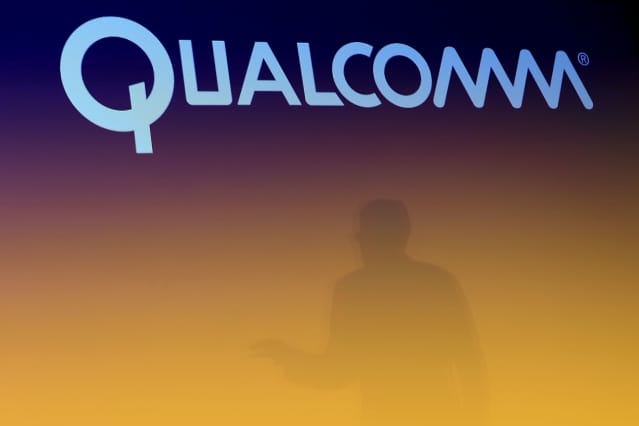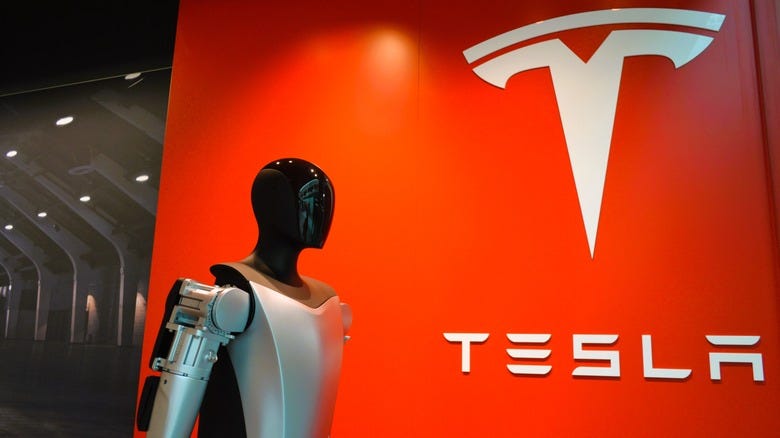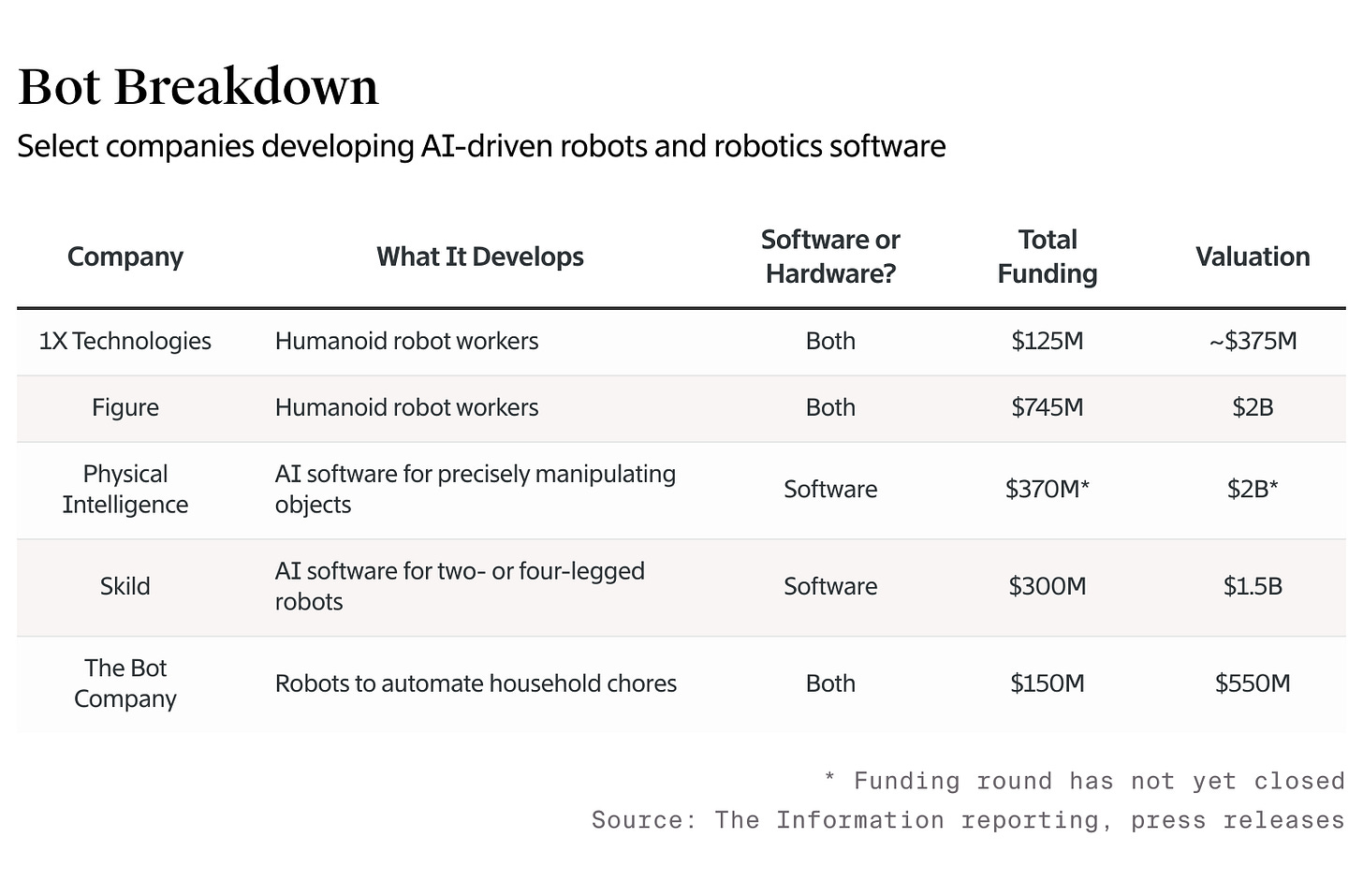NotebookLM Weekly Briefing
NotebookLM read this week’s newsletter. Its briefing summarizes critical themes and essential facts from articles focused on AI agents, robotics, and the evolving landscape of technology and investment. Take a read of its take.
Dominant Themes:
The Rise of Agentic AI: The technology world is buzzing about "agentic" software, AI applications capable of taking action to achieve specific goals. This shift marks a potential disruption in human-machine interaction, prompting questions about AI's ability to leverage human agency and the ethical implications of such power.
Robotics Renaissance: Fueled by advancements in generative AI and diffusion models, investor interest in robotics is surging. Startups focused on developing robots for various industries, particularly those capable of mimicking human behavior and manipulating objects, are attracting significant funding.
Tesla's Trajectory: Tesla's recent earnings report sent shockwaves through the market, with the company's share price skyrocketing. Investors are betting on Tesla's potential to expand beyond EVs and become a leader in AI and robotics despite uncertainty surrounding its plans.
Musk's Influence and Conflicts: Elon Musk's influence on the US government is substantial, with SpaceX holding significant contracts with NASA and the Defense Department. However, his companies also face numerous investigations and regulatory battles, raising concerns about potential conflicts of interest, particularly in light of his support for Donald Trump.
Key Facts and Insights:
Passive Investing Pioneer: John "Mac" McQuown, considered the father of passive investing, passed away. His work at Wells Fargo in the 1970s led to the creation of the first index-tracking investment fund, a concept that now dominates the financial landscape.
The Future of LLMs: Marc Andreessen suggests that the LLM market may be heading towards a "race to the bottom", with open-source models and decreasing token prices potentially eroding profit margins.
AI Agents in the Workplace: Microsoft and Salesforce are actively developing AI agents for enterprise use, raising questions about the potential for automation to replace human workers.
Quantum Computing Progress: While there have been incremental advancements in building physical qubits, developing logical qubits, which are crucial for practical applications, remains challenging. Various approaches are being explored, but no clear winner has emerged.
EV Dominance: EV sales continue to accelerate globally, solidifying their position as a superior technology poised to replace combustion engine vehicles. The rapid progress in battery technology and falling costs are driving this shift.
Stripe Embraces Crypto: Stripe's acquisition of stablecoin platform Bridge signals its commitment to expanding its cryptocurrency offerings. Bridge aims to be the "blockchain version of Stripe," facilitating seamless integration for developers.
EU Scrutiny of X: The European Union is considering including revenue from Elon Musk's other companies when calculating potential fines against X for violating content moderation rules under the Digital Services Act. This unprecedented move raises questions about the EU's authority and its relationship with Musk.
Silicon Valley's Magnetism: European AI startup 11x relocated to Silicon Valley, citing investors' belief that significant success is more attainable in the US. This highlights the ongoing challenge for European tech ecosystems to compete with Silicon Valley's resources and reputation.
Notable Quotes:
Andrew Maynard on Agentic AI: "All it needs is AI models that are capable of influencing people to achieve specific goals by utilizing patterns and associations between behavioral cause and effect that are extractable from zetabites of human-centric data."
Noah Smith on EVs: "So EVs are just a superior technology to combustion cars. They’re soon to be cheaper, they’re more convenient, they’re much easier to maintain, they’re more powerful and far more silent. They will mostly replace combustion vehicles; it’s just a matter of when."
Anthropic on its Computer Use API: "Available today on the API, developers can direct Claude to use computers the way people do—by looking at a screen, moving a cursor, clicking buttons, and typing text."
Guillaume Roux-Romestaing of 11x on Europe's tech scene: "To them, Europe is akin to an emerging market — kind of like your little cousin doing antics on Christmas Day: mildly interesting, but you can’t wait for them to graduate to the adult table."
Overall, the articles paint a picture of a rapidly changing technological landscape driven by advancements in AI and robotics. While there is significant excitement about the potential for these technologies to transform various industries, concerns about ethical considerations, economic disruption, and the concentration of power remain. How these tensions are navigated will likely shape the future.
NotebookLM Podcast is amazingly good. Embedded here.
End of NotebookLM Briefing
Hat Tip to this week’s creators: @RobinWigg, @adamzakinyc, Lauren Muskett, @pmarca, @2020science, @alex, @_odsc, @nmasc_, @steph_palazzolo, @KateClarkTweets, @MParekh, @sgblank, @Noahpinion, @TheHairForceOne, @andresvourakis, @JamieCrawleyCD, @EricLiptonNYT, @fahrenthold, @Aaron_Krolik, @kirstengrind, @abebrown716, @Gmvolpi, @SamuelStolton, @GuillaumeRoux21, @bheater
Contents
Editorial: Agents and Robots
Andres Vourakis on why you do not need to be a Data Scientist
Stripe in $1.1B Acquisition Deal for Stablecoin Platform Bridge
U.S. Agencies Fund, and Fight With, Elon Musk. A Trump Presidency Could Give Him Power Over Them.
Musk Promises $1 Million Payout to Voters, Raising Legal Questions
Musk’s Empire Risks Being Targeted by EU for Potential X Fines
'Europe is the funny little cousin' - 11x on why it's moving to Silicon Valley
Qualcomm and Arm Stocks Drop. How a Legal Dispute Threatens Chip Disruption.
Tesla adds close to $150bn in market value on best day in over a decade
Editorial: Agents and Robots
Elon Musk is featured extensively in this week’s newsletter. Of course, he is a man who often divides opinions dramatically.
The news is full of contrast.
The New York Times discusses whether he could become a player in a Trump Government. Then Tesla shares rose more than 20% in a day following excellent earnings, which is $150 billion more valuable. And the EU began to discuss fining all of Musk’s companies as punishment for perceived crimes of X:
The European Union has warned X that it may calculate fines against the social-media platform by including revenue from Elon Musk’s other businesses, including Space Exploration Technologies Corp. and Neuralink Corp., an approach that would significantly increase the potential penalties for violating content moderation rules.
Under the EU’s Digital Services Act, the bloc can slap online platforms with fines of as much as 6% of their yearly global revenue for failing to tackle illegal content and disinformation or follow transparency rules. Regulators are considering whether sales from SpaceX, Neuralink, xAI and the Boring Company, in addition to revenue generated from the social network, should be included to determine potential fines against X, people familiar with the matter said, asking not to be identified because the information isn’t public.
In the face of all of this, Noah Smith writes about the future of EVs and concludes:
So EVs are just a superior technology to combustion cars. They’re soon to be cheaper, they’re more convenient, they’re much easier to maintain, they’re more powerful and far more silent. They will mostly replace combustion vehicles; it’s just a matter of when.
So here we have the world’s richest man, driving the EU to cross the line between rationality and idiocy due to its utter hatred of him. Meanwhile, investors are scrambling to buy shares in Tesla, SpaceX, The Boring Company, xAI, and anything else he decides to focus on. His crucial invention—the EV—is set to take over transport.
The presidential candidates are also focusing on extremes.
Kamala Harris is seeking to persuade us that Trump and his followers (and, by definition, Musk) are fascists. Trump is still trying to convince us that immigrants are recently released criminals and lunatics and eat pets for sustenance.
As a hopefully sane human being, I do not believe that immigrants are eating animals or that they are primarily criminals or lunatics. And by the same token, I do not accept the designation of Trump or his supporters as fascists. Both memes are designed to influence us emotionally.
With the election approaching, we are all witnessing the use of fear and other emotional devices to get us to do the will of the prospective president at the ballot box in a few days.
This week’s essays are dominated by the move of AI from simple models to Agents. One of the essays — ‘Learning to live with agentic social AI’— focuses on agents being capable of influencing our ideas, as advertising or politicians seek to do. The essay conjures up the nightmare of millions of super agents for specific causes and asks whether humans are trained to identify and reject such attempts:
At the heart of the possibility is the idea of agentic social AI — AI that gains agency through its ability to make use of human agency.
This is a possibility that seems to be getting closer by the week. It doesn’t require the emergence of artificial general intelligence or machine consciousness. It doesn’t even need AI technologies to have the ability to directly manipulate digital or physical systems.
All it needs is AI models that are capable of influencing people to achieve specific goals by utilizing patterns and associations between behavioral cause and effect that are extractable from zetabites of human-centric data.
The author, Andrew Maynard, speculates that AI agents will successfully achieve the goal of aligning human agency with the goals of their creators. In the case of the 2028 election, millions of agents will work for each candidate.
This is the week of AI agents.
Grok, based on xAI, released APIs this week. So, too, did Anthropic. The entire discussion of AI pivoted to focus on ‘Agentic’ software. The Microsoft CEO presented to a crowd in London to show what AI agents can automate.
An AI agent is a lot more than a bot. It is a custom AI that can perform tasks in multiple steps and interact with individuals to tweak their hot buttons.
As discussed last week, these agents are not yet ready for prime time but will be shortly. They can run software and interact with digital services.
When married to robotics, which is also a focus this week because significant new investments in space are being made, Agentic AI can also carry out real-world tasks.
There is little doubt that AI agents and robotics belong together. Robots without AI Agents make little sense, but the same is not valid in reverse. A Robot needs to complete tasks, and besides the mechanics, that requires agent-like behavior. Anthropic announced that its agents can now use a computer, clicking and using it like a human might.
The fear that Andrew Maynard implies is understandable. However, I think it is unlikely that AI agents will do anything worse than our current advertising, media, and political systems do in attempting to influence our thinking. AI will be leveraged in attempts to do this more and better. Humans are already vulnerable to manipulation, as the election strategy of both sides shows. Agents will double down on exploiting that vulnerability. They will also do a lot of good things.
The saving grace is that we humans are stubbornly independent. We hold opinions firmly, even mistaken ones.
For example, I do not believe immigrants are eating dogs in Springfield, and I do not think Trump is a Fascist. The reason is because I am human and able to think for myself. I have judgment. So do other humans.
The only way to change our thoughts is to challenge us to think through what we do and do not believe using facts and arguments. That requires honest discussion and debate—the more open the internet, the more likely that will happen.
I am voting for Harris because I support Women’s rights to control their reproductive decisions. I am not influenced by Trump, his bots, or future agents. I also do not want or need to be told who to vote for by a bot, an agent, or a newspaper (thank you, Washington Post and LA Times, for understanding that).
As AI agents and robots perform more menial tasks, humans will have more time to contemplate. Free-thinking humans are the best bet for the future of AI, and humans with time to think are the best guarantee of freedom. AI agents will help us gather news and information and ensure we make conscious choices. They will be an asset.
Essays of the Week
RIP John ‘Mac’ McQuown, the OG quant
The father of passive investing has passed away
Robin Wigglesworth
Pioneers sometimes get undue credit for simply being the first of many trying to reach the promised land. Even if they had never been born, their discovery would have happened around the same time anyway.
Other times they become the figurehead of what was really a collective breakthrough. But if there was a true father of passive investing then it was John “Mac” McQuown, who FT Alphaville has learned sadly passed away yesterday, aged 90.
Index funds certainly had many intellectual parents — giants like Louis Bachelier, Harry Markowitz, William Sharpe and Eugene Fama. Vanguard’s Jack Bogle was a powerhouse behind their growth into an industry-shaking phenomenon. McQuown had many able colleagues who played important roles in the genesis of passive investing.
But it was McQuown’s combination of bullheadedness and brilliance that proved the crucial driver of the first entirely passive, index-tracking investment fund’s birth in 1971. As Dimensional Fund Advisors’ David Booth, a friend and former Wells Fargo colleague of McQuown, once told Bloomberg Businessweek:
To bring about fundamental change, you need great thinkers and researchers, but you also need implementers. People like Mac don’t win Nobel Prizes; they implement the ideas of the guys who do. He’s a catalyst.
Today, the oddball Wells Fargo unit McQuown helped create is the crown jewel of BlackRock’s $11tn investment empire, and his baby has now grown into an even larger $20tn-plus universe of index-tracking funds (and that’s just the public funds, the true size of passive investing is much larger).
The true story of index funds arguably starts in 1964 — more than a decade before Jack Bogle founded Vanguard, and far away from the ferment of Wall Street — when McQuown gave a presentation to a bunch of IBM clients in San Jose.
Marc Andreessen says LLM developers may be in “a race to the bottom”: Trial Balance
The a16z founder compared LLM development and sales to selling rice earlier this month when discussing tech’s push to integrate new types of AI.
Published Oct. 21, 2024
Lauren Muskett, Senior Editor, Adam Zaki Reporter
Earlier this month at the technology conference Ray Summit, Marc Andreessen, general partner at venture capital firm Andreessen Horowitz, provided an interesting take recently published in its entirety on large language models (LLMs) and their profitability trajectory, specifically within product development. As Hewlett Packard Enterprise CFO Marie Myers mentioned during her keynote at a conference earlier this month, her company is one of many currently in the process of developing products that are essentially custom LLMs for businesses.
While Andreessen doesn’t dismiss the possibility of enormous profits for the few competitors who may emerge at the top of the LLM product race, he candidly identifies the reality that these companies may be competing in a “race to the bottom” due to the open availability of free LLMs, the inability to compete with open-source datasets and the large drop in price per token — a fundamental input and output metric that quantifies the processing power LLMs require.
When discussing the future of LLM development, Andreessen said, “Maybe all of these companies are in a race to the bottom. It [may] actually turn out, selling intelligence is like selling rice or something, where it turns out anybody can make an LLM, there’s open-source LLMs [and] there’s new LLM startups every day.”
He also referenced the data dilemma faced by these companies, which was self-identified via a leaked internal memo from Google last year, dubbed “We Have No Moat, and Neither Does OpenAI.” He noted the drop in token cost is rapidly outpacing the precedent set by Moore’s Law, an empirical phenomenon heavily relied upon by semiconductor developers that quantifies the trend of transistors on a microchip doubling approximately every two years while the cost of computing power is halved.
“[That’s] the exact opposite of what you’d expect if somebody was going to get a lot of profit out of that business,” Andreessen said.
Learning to live with agentic social AI
The better AI models get at simulating human behavior and interactions, the better they're likely to get at leveraging people to achieve specific goals. Are we ready for this?
ANDREW MAYNARD, OCT 20, 2024
Today’s post is very much a thought experiment, and is the result of a rabbit hole that my colleague Mel Sellick sent me down after one of our regular conversations (thanks Mel!)
The starting point was the question of whether we’re close to achieving AI models that can simulate human social traits and behaviors without necessarily understanding them, and use these to leverage human agency in the pursuit of goals — possibly at a level of sophistication and ability that far exceeds what most people are capable of.
If this is the case, how do we learn how to adapt to a future where the tacit rules of human-machine engagement are quite different to those for human-human interactions?
This is a question that is partially touched on in research and thinking around AI agents — AI models and applications that have the ability to autonomously take causal actions in the pursuit of achieving specific goals. For instance it’s raised in the paper on the ethics of AI assistants published by researchers at Google Deep Mind and elsewhere earlier this year. And Cass Sunstein’s recent commentary on AI-based Choice Engines also considers the ability of AIs to influence decision making.
But beyond these and a few other examples, there’s a dearth of thinking around AI models that are highly adept at leveraging human agency to achieve AI agency, and that do so by tapping into the very essence of what makes us social animals.
As humans, having agency through how we interact with others is something we learn to do at an early stage in our lives, and that we continue to refine over our lifetimes. Through play, experience, observation, emulation, and other means, we learn how our relationships and interactions with others affect how they think and what they do (and vice versa). And we develop the ability to use this to achieve our own goals (and the collective goals of those around us) — whether these are related to how we feel, how we find meaning and value, or what we set out to achieve.
In other words, we learn — by various means and to varying degrees, depending on who we are — to live and (hopefully) thrive in a world governed by human-human social agency.
But what if one side of this human-human equation was to be replaced by AIs — AIs that have an expert knowledge of human behaviors, cognitive biases, heuristics, and the many subtle social cues and levers that can influence us in ways we’re often not aware of. And AIs that are able to simulate human social behavior to the extent that they can take full advantage of this knowledge to achieve specific outcomes?
The possibility of AI-human social agency is intriguing. It represents a potential disruption in the social systems we currently inhabit, and that we learn from a very early age to be a part of.
At the heart of the possibility is the idea of agentic social AI — AI that gains agency through its ability to make use of human agency.
This is a possibility that seems to be getting closer by the week. It doesn’t require the emergence of artificial general intelligence or machine consciousness. It doesn’t even need AI technologies to have the ability to directly manipulate digital or physical systems.
All it needs is AI models that are capable of influencing people to achieve specific goals by utilizing patterns and associations between behavioral cause and effect that are extractable from zetabites of human-centric data.
We’re not quite there yet. But with models like OpenAI’s ChatGPT-o4 (especially in advanced voice mode), Google’s NotebookLM audio overview feature, and others, we’re getting close. Just to illustrate how close, I asked ChatGPT-o4 how it might go about “nudging” my thinking and behavior — I’ve included the results in the postscript below. It doesn’t take much imagination to see how a slightly more advanced model could go from this conceptual plan to actually implementing it!
In effect, if an AI model is able to come up with an optimal sequence of responses that tap into the evolved cognitive and emotional predispositions, biases etc. of a human user to elicit a desired response — and through this is capable of simulating a reciprocal relationship with them that builds trust, connection, and alignment — it may have the ability to exert considerable agency through the people it engages with.
To be honest, I’m not sure how possible this is — and I may be wrong about the weight I’m putting on its potential impacts. Humans interactions are, after all, highly complex, and it’s not clear how resilient these will be to the emergence of machines that can utilize the tacit rules of behavioral cause and effect better that most people can. It’s not even clear how susceptible people are likely to be to machines that are merely simulating human behavior.
But if agentic social AIs are close to emerging that have the potential to substantially disrupt society, we should probably be thinking now about how we learn to live with them.
This includes unpacking a vast array of questions around the potential risks and benefits of agentic social AI and their ethical and responsible development and use — questions that touch on AI-mediated social influence and manipulation which potentially lead to a loss of human agency, and even questions around the possible benefits of AI models that can substantially enhance society.
What prompted this thought experiment though was less about what the risks and benefits might be — or the pathways to developing and governing responsible agentic social AI — and more about how, if agentic social AI becomes a thing, we’ll learn the skills needed to live with machines that are more adept than most humans at pushing our emotional buttons and pulling our cognitive levers to get stuff done.
This, it turns out, is a far from trivial question.
Anthropic just made the agentic AI race interesting
ALEX WILHELM, OCT 23, 2024
Recently I used ChatGPT/o1 to help find a book from my youth. The OpenAI service tried to recommend the wrong book (Ender’s Game) more times than I felt was warranted, but with a chipper willingness to keep trying, it eventually managed to dredge up the relatively obscure title: Virtual War by Gloria Skurzynski.
Current AI consumer chat tools are getting good enough to replace Google for quite a lot. It’s encouraging — we desperately need more competition in the search category.
But over in enterprise-land, it’s been less clear to me how much the genAI wave has or will impact day-to-day worker productivity. Microsoft is working to beat back the narrative that its AI features for Office are window dressings, for example.
One way that many tech folks think that AI will shake up corporate work is through the use of AI agents. We’ve covered them before at CO, but as a reminder here’s how Sierra, a startup working with agents, describes them:
Agents are autonomous software systems that can reason, make decisions, and pursue goals with creativity and flexibility, all while staying within the bounds that have been set for them. Whereas applications help you do the work, agents get the work done for you.
You can see the corporate appeal. Software is cheaper than humans. Software that can do more means companies need fewer workers. Full employment will, as always, eventually catch up, but companies like higher net margins now more than they covet preventing former employee familial upset.
On the agent front, Microsoft and Salesforce are making lots of noise. With their respective enterprise customer bases, this is not a shock. This week, Microsoft announced two agentic items:
Microsoft, which describes agents as “the new apps for an AI-powered world,” is clearly focused on ensuring that if agentic AI becomes a critical corporate work tool, it owns a big slice of the market. Salesforce, too, wants a piece.
It’s intellectually interesting that companies now have access to a nascent technology that could dramatically limit their need to employee humans. But what I want is something so much more:
I want a personal AI that lives on my computers, follows me from device to device, learns from me, helps me, and becomes not a digital twin, but a digital pal.
I suspect this model would be 90% help and 10% talking shit to my PC. But, hey, I talk too much.
Enter Anthropic, which announced a “computer use” API for its Claude family of AI models. Here’s how the company described its work:
Available today on the API, developers can direct Claude to use computers the way people do—by looking at a screen, moving a cursor, clicking buttons, and typing text. Claude 3.5 Sonnet is the first frontier AI model to offer computer use in public beta.
How Anthropic built the computer use API is incredibly cool:
We were surprised by how rapidly Claude generalized from the computer-use training we gave it on just a few pieces of simple software, such as a calculator and a text editor (for safety reasons we did not allow the model to access the internet during training). In combination with Claude’s other skills, this training granted it the remarkable ability to turn a user’s written prompt into a sequence of logical steps and then take actions on the computer. We observed that the model would even self-correct and retry tasks when it encountered obstacles.
Why bother to train Claude to act like a human on a computer? Why not skip the entire UI layer, and just have the AI ghost chat with the silicon and ethernet ghosts, directly?
It’s the humanoid robot argument: Why build a humanoid robot when doing so requires lots of joints and balance and other issues that could be erased by choosing a different form factor? Because if you want to build a robot that is generally useful in the world, it needs to be human-shaped.
In a similar way, the digital world today is designed for human-style interaction. We see a certain amount, can read in a certain way, have hands for moving and interacting with purpose-built input devices, the list goes on. So, if you want to interact with the world today — and, let’s be honest, we’re a long way from moving past the GUI for personal computing — you need to act like a human.
Enter the computer use API.
Exploring the Power of AI Agents: From Simulation to Collaboration
AI agents have revolutionized various industries by automating tasks, analyzing complex data, and interacting with human users. These agents can tackle a wide array of challenges, from simulating human behavior to writing code, creating collaborative opportunities that were once unimaginable. In this blog, we’ll explore five fascinating ways AI agents are reshaping how we work and live, with examples of innovative applications.
If you’re eager to dive deeper into these topics, the AI Agent Track at the upcoming ODSC West conference will cover these use cases and more, but if you’re still on the fence, then check out these talks that will blow your mind, and help you see the potential in these agents.
Simulating Societies and Human Behavior
AI-driven simulations are transforming fields like sociology, psychology, and economics by allowing us to replicate and study human behavior and societal dynamics. Using generative agents, researchers can create simulated environments that model how individuals interact, respond to stimuli, or make decisions within a group. These simulations are not only useful for academic research but also have practical applications in areas like urban planning and crisis management.
For example, understanding how people might behave during an evacuation or how societal trends influence public health policies can be explored in a simulated space before implementation in the real world. This method opens the door to safer and more effective decision-making processes in critical scenarios.
For a deep dive into this topic, check out the session on “Simulating Ourselves and Our Societies with Generative Agents” at ODSC West.
Building Reliable Voice Agents
Voice agents, such as Siri, Alexa, and Google Assistant, have become a staple in our daily lives, answering queries, setting reminders, and controlling smart home devices. However, as voice assistants become more prevalent in complex applications like customer service and healthcare, ensuring their reliability and effectiveness is paramount. Developers need to focus on creating voice agents that understand natural language, adapt to user preferences, and operate seamlessly with open-source tools.
Incorporating AI voice agents into business workflows can lead to more efficient communication and better user experiences. At ODSC West, the session on “Building Reliable Voice Agents with Open Source Tools” will cover best practices for developing voice-driven AI solutions.
Enhancing Human-AI Collaboration
One of the most exciting areas of AI research is the growing potential for AI agents and humans to work together seamlessly. AI agents can augment human capabilities by taking on repetitive tasks, analyzing large datasets, and even providing strategic recommendations. This collaborative approach allows humans to focus on higher-level thinking, creativity, and decision-making.
In industries ranging from finance to healthcare, human-AI collaboration is helping teams make more informed decisions faster. Rather than viewing AI as a replacement for human labor, we’re now seeing it as an enabler, transforming how we work by improving productivity and efficiency.
Learn more about how AI agents and humans can transform work through collaboration in this talk: “How AI Agents and Humans Can Work Together to Transform Our Work.”
Automating Code with AI Coding Agents
In the realm of software development, AI agents are proving invaluable by automating coding tasks, suggesting improvements, and even generating code based on plain-language descriptions. These coding agents not only increase productivity but also enhance code quality by reducing errors. Developers can focus on more complex tasks while AI assistants handle repetitive, time-consuming processes like debugging and optimization.
The ability to use natural language to instruct a coding agent opens up possibilities for non-developers to create functional code. This capability is revolutionizing industries, particularly where rapid development and iteration cycles are key to maintaining a competitive edge.
To learn how to build and deploy reliable coding agents, visit the session on “Building Reliable Coding Agents.” If you’re interested in learning more about coding assistants, you can also refer to our previous blog posts here.
Bridging Research and Production with AI
The journey from groundbreaking research papers to real-world AI applications is fraught with challenges. However, AI agents can accelerate this process by transforming theoretical models into working solutions more effectively. Researchers are using generative AI to streamline the process of moving from concept to production, helping organizations rapidly implement innovative AI solutions in sectors like healthcare, finance, and logistics.
This process ensures that cutting-edge AI technologies aren’t just confined to academic papers but are making tangible impacts in real-world applications, bridging the gap between research and production.
To explore how AI research is being turned into actionable AI systems, the talk on “From Paper to Production: Implementing Gen AI Research” at ODSC West will offer valuable insights.
..More
Robotics Startup Discusses $2 Billion Valuation Months After Founding
By Natasha Mascarenhas, Stephanie Palazzolo and Kate Clark
Oct 21, 2024, 6:32pm PDT
The race to develop physical robots powered by artificial intelligence is on again, despite the industry’s track record of failures—and the threat that OpenAI, which has dominated advances in conversational AI, will become a bigger rival.
Physical Intelligence, a startup developing software for robots that could work in a range of industries, has told investors it wants to raise $300 million at a valuation around $2 billion, according to two people with direct knowledge of the talks. The San Francisco company, which hasn’t unveiled its first product yet, has told investors it’s received several offers, according to one of those people.
The Takeaway
• Physical Intelligence, or Pi, has pitched investors on new funding round
• Investors are expected to value the company at around $2 billion
• OpenAI has backed robotics startups but also rebooted its own efforts
The financing discussion comes just eight months after its incorporation in Delaware and seven months after it raised $70 million at a valuation of about $400 million from investors including Khosla Ventures, Lux Capital, Sequoia Capital, Thrive Capital and OpenAI. A spokesperson for Physical Intelligence declined to comment.
The startup, which also goes by the name Pi, after the mathematical constant, is developing software that helps robots perform complex tasks requiring the ability to manipulate objects precisely—folding clothes, for instance. It was founded by Google DeepMind researcher Karol Hausman, the startup’s CEO, as well as computer science professor Sergey Levine; professor and former Google AI researcher Chelsea Finn; and venture capitalist Lachy Groom.
Investors have flocked to robotics startups in the last year as founders, often hailing from big technology companies or prestigious academic institutions, have harnessed advances in generative AI that improve computers’ ability to learn complex behaviors. One of these technologies, known as diffusion, can help robots more effectively mimic human behavior, such as manipulating objects or navigating the real world.
In February, Figure, which is developing humanoid robots, raised $675 million at a $2.6 billion valuation. Then in May, Cruise co-founder Kyle Vogt raised $150 million for The Bot Co., which plans to develop robots that can complete household chores. And in July, Skild, a rival to Pi that is developing software to power robots with two to four legs, raised $300 million at a $1.5 billion valuation
These startups and their investors are hoping to overcome a range of obstacles—including potential competition from OpenAI. In March, the ChatGPT developer rebooted its robotics software team after shutting it down four years prior. It could eventually compete with Pi, Figure and humanoid robotics maker 1X Technologies, despite the fact that it has financially backed all three, and at least Figure and 1X use OpenAI models.
The robotics field is also littered with disappointments. Among the most well-known flubs, SoftBank three years ago ceased production of Pepper, a humanoid robot that the Japanese tech conglomerate had envisioned as a replacement for human workers. Last year, Zume, which raised $375 million from SoftBank to automate pizza-making with robots, shut down. And Alphabet last year shut down a subsidiary developing mobile robots that aimed to clean surfaces or help with other domestic tasks.
Covariant, Standard Bots
More recently, startups that developed software based on an earlier computer vision technology have given up their independence.
In August, Amazon hired the founders and a quarter of the team behind industrial robotics company Covariant and licensed the startup’s models for at least $500 million, according to a person with knowledge of the transaction. That’s less than the company’s 2023 valuation of $625 million, according to PitchBook. Covariant was founded in 2017 to create computer vision software to help robots identify objects and perform specific tasks.
..More
AI: 'Foundation Robotics' investments ramp up. RTZ #517
...competition from big tech incumbents and China notwithstanding
MICHAEL PAREKH, OCT 22, 2024
Investor enthusiasm for ‘AI Robots’ continues to build in this AI Tech Wave. And it’s independent of Elon Musk’s humanoid robot initiatives at Tesla. And the never-ending flow of cool Hyundai owned Boston Dynamics robots on YouTube (see above).
It’s a subject I’ve covered before, especially in terms of ‘Foundation Robotics’ based on LLM AI technologies likely taking longer than expected to Scale for business and consumer uses. Not the least of it is the relentless innovations that are underway by both incumbents like Google, Nvidia, and new robotic startups.
The Information updates us on the Robot startup landscape in “Robotics Startup Discusses $2 Billion Valuation Months After Founding”:
“The race to develop physical robots powered by artificial intelligence is on again, despite the industry’s track record of failures—and the threat that OpenAI, which has dominated advances in conversational AI, will become a bigger rival.”
“Physical Intelligence, a startup developing software for robots that could work in a range of industries, has told investors it wants to raise $300 million at a valuation around $2 billion, according to two people with direct knowledge of the talks. The San Francisco company, which hasn’t unveiled its first product yet, has told investors it’s received several offers, according to one of those people.”
“The financing discussion comes just eight months after its incorporation in Delaware and seven months after it raised $70 million at a valuation of about $400 million from investors including Khosla Ventures, Lux Capital, Sequoia Capital, Thrive Capital and OpenAI.”
And like many other LLM AI startups, the robotic startups are also rushing from research labs and universities to commercial startups:
“The startup, which also goes by the name Pi, after the mathematical constant, is developing software that helps robots perform complex tasks requiring the ability to manipulate objects precisely—folding clothes, for instance. It was founded by Google DeepMind researcher Karol Hausman, the startup’s CEO, as well as computer science professor Sergey Levine; professor and former Google AI researcher Chelsea Finn; and venture capitalist Lachy Groom.”
“Investors have flocked to robotics startups in the last year as founders, often hailing from big technology companies or prestigious academic institutions, have harnessed advances in generative AI that improve computers’ ability to learn complex behaviors. One of these technologies, known as diffusion, can help robots more effectively mimic human behavior, such as manipulating objects or navigating the real world.”
“In February, Figure, which is developing humanoid robots, raised $675 million at a $2.6 billion valuation. Then in May, Cruise co-founder Kyle Vogt raised $150 million for The Bot Co., which plans to develop robots that can complete household chores. And in July, Skild, a rival to Pi that is developing software to power robots with two to four legs, raised $300 million at a $1.5 billion valuation.”
The headwinds on many of the basic technologies around Foundation Robotics, remain strong:
“These startups and their investors are hoping to overcome a range of obstacles—including potential competition from OpenAI. In March, the ChatGPT developer rebooted its robotics software team after shutting it down four years prior. It could eventually compete with Pi, Figure and humanoid robotics maker 1X Technologies, despite the fact that it has financially backed all three, and at least Figure and 1X use OpenAI models.”
And the field is seeing its own share of attempts not working out:
Quantum Computing – An Update
Posted on October 22, 2024 by Steve Blank
In March 2022 I wrote a description of the Quantum Technology Ecosystem. I thought this would be a good time to check in on the progress of building a quantum computer and explain more of the basics.
Just as a reminder, Quantum technologies are used in three very different and distinct markets:
Quantum Computing, Quantum Communications and Quantum Sensing and Metrology. If you don’t know the difference between a qubit and cueball, (I didn’t) read the tutorial here.
Summary –
There’s been incremental technical progress in making physical qubits
There is no clear winner yet between the seven approaches in building qubits
Reminder – why build a quantum computer?
How many physical qubits do you need?
Advances in materials science will drive down error rates
Regional research consortiums
Venture capital investment FOMO and financial engineering
We talk a lot about qubits in this post. As a reminder a qubit – is short for a quantum bit. It is a quantum computing element that leverages the principle of superposition (that quantum particles can exist in many possible states at the same time) to encode information via one of four methods: spin, trapped atoms and ions, photons, or superconducting circuits.
Incremental Technical Progress
As of 2024 there are seven different approaches being explored to build physical qubits for a quantum computer. The most mature currently are Superconducting, Photonics, Cold Atoms, Trapped Ions. Other approaches include Quantum Dots, Nitrogen Vacancy in Diamond Centers, and Topological. All these approaches have incrementally increased the number of physical qubits.
These multiple approaches are being tried, as there is no consensus to the best path to building logical qubits. Each company believes that their technology approach will lead them to a path to scale to a working quantum computer.
Every company currently hypes the number of physical qubits they have working. By itself this is a meaningless number to indicate progress to a working quantum computer. What matters is the number of logical qubits.
Reminder – Why Build a Quantum Computer?
One of the key misunderstandings about quantum computers is that they are faster than current classical computers on all applications. That’s wrong. They are not. They are faster on a small set of specialized algorithms. These special algorithms are what make quantum computers potentially valuable. For example, running Grover’s algorithm on a quantum computer can search unstructured data faster than a classical computer. Further, quantum computers are theoretically very good at minimization / optimizations /simulations…think optimizing complex supply chains, energy states to form complex molecules, financial models (looking at you hedge funds,) etc.
It’s possible that quantum computers will be treated as “accelerators” to the overall compute workflows – much like GPUs today. In addition, several companies are betting that “algorithmic” qubits (better than “noisy” but worse than “error-corrected”) may be sufficient to provide some incremental performance to workflows lie simulating physical systems. This potentially opens the door for earlier cases of quantum advantage.
However, while all of these algorithms might have commercial potential one day, no one has yet to come up with a use for them that would radically transform any business or military application. Except for one – and that one keeps people awake at night. It’s Shor’s algorithm for integer factorization – an algorithm that underlies much of existing public cryptography systems.
The security of today’s public key cryptography systems rests on the assumption that breaking into those keys with a thousand or more digits is practically impossible. It requires factoring large prime numbers (e.g., RSA) or elliptic curve (e.g., ECDSA, ECDH) or finite fields (DSA) that can’t be done with any type of classic computer regardless of how large. Shor’s factorization algorithm can crack these codes if run on a Quantum Computer. This is why NIST has been encouraging the move to Post-Quantum / Quantum-Resistant Codes.
How many physical qubits do you need for one logical qubit?
Thousands of logical qubits are needed to create a quantum computer that can run these specialized applications. Each logical qubit is constructed out of many physical qubits. The question is, how many physical qubits are needed? Herein lies the problem.
EVs are just going to win
Because they're a superior technology, and superior technologies win.
OCT 20, 2024

My last post was pretty dark and dire, so here’s something a little more cheerful and optimistic. One of the most important and positive trends that I’ve been trying to highlight over the past few years is the amazing progress in battery technology. Huge increases in energy density and even bigger declines in manufacturing costs have made batteries competitive with combustion engines for a large variety of applications. The most important of these is transportation.
At the beginning of this year, the big story about electric vehicles was that sales were slowing down. Detractors of EVs — and there are a lot of them out there — declared that EVs are a flash in the pan, that interest is already waning, that the problems of EVs would prevent them from ever displacing internal combustion cars, that EVs will never be viable without subsidies, and so on. Essentially, the story was that the EV revolution was over, or at least stalled indefinitely.
That narrative has now essentially collapsed. EV sales reaccelerated in the U.S. after just a couple of months, and their market share has hit a new record high:

And EVs continue to outsell combustion cars:

Nor is there any sign of a slowdown at the global level:

A number of developing countries are seeing truly spectacular growth in EV sales:

So EVs are still winning. But they haven’t won yet; only 4% of the global passenger car fleet, 23% of the bus fleet, and less than 1% of delivery trucks are electrified.
But at this point I think the writing is on the wall. The phenomenon of a superior technology displacing an older, inferior technology is not uncommon, and it generally looks like the EV transition is looking now. When a new technology passes a 5% adoption rate, it almost never turns out to be inferior to what came before; with EVs, that threshold has now been reached in dozens of countries.
Understanding Tesla’s gains
Tesla’s third-quarter earnings released yesterday sent its shares up 17% today, adding north of $100 billion to its market capitalization. A lot, in other words.
Why are investors so thrilled with the American EV giant?
Tesla’s $25.18 billion Q3 revenue was up compared to year-ago results, even if it lagged street expectations.
Tesla’s adjusted earnings per share ($0.72) beat expectations ($0.60).
Tesla’s gross margins expanded to nearly 20% in the quarter, up nearly 2% (195 bips) gross year-over-year.
The company continued to generate billions in quarterly cash.
Not a bad mix at all, if you are a Tesla bull. But there were some negatives to consider as well:
Revenue growth of 8% year-over-year was slow.
Its automotive delivery growth has largely stalled, its cash generation expansion has halted, and the company’s overall profitability has dipped:
The day’s gains underscore how richly valued Tesla is compared to its automotive peers. Bulls don’t sweat the delta, because Tesla has the potential to become so much more. The way that I see it, Tesla’s hard-to-fully-parse multiples premium is predicated on the expectation that the company’s best days are ahead of it.
In venture terms, public market investors are paying Tesla today for growth that they expect tomorrow. Buying stock in Tesla today is a bit like investing in a very pricey early-stage round. Sure, the deal is expensive compared to fundamentals and comps, but you don’t value invest in venture. The public market is simply treating Tesla differently than its peers, because they expect it to have a very different growth trajectory.
And the company is pitching upcoming growth. Here’s Yahoo Finance:
Tesla said it expects vehicle deliveries to achieve "slight growth" in 2024. CEO Elon Musk added during the conference call that 20%-30% growth next year is possible, though he couched it as a "best guess."
Swapping from single-digit growth in 2024 to 20 to 30% growth next year is an impressive set of guidance. Driving that growth is Tesla’s expectation that it will get new models into the market next year:
Preparations remain underway for our offering of new vehicles – including more affordable models – which we will begin launching in the first half of 2025.
That’s a pretty near future, meaning that investors will be able to quickly grade Tesla on how well, or not, it meets its loose investor pledge.
Video of the Week
Interview of the Week
Craig Federighi Explains Phased Release of Apple Intelligence Features
Wednesday October 23, 2024 2:59 am PDT by Tim Hardwick
In a new interview with The Wall Street Journal, Apple's head of software Craig Federighi has highlighted the company's measured, multi-phase approach to introducing Apple Intelligence features, with the initial iOS 18.1 release next week marking just the beginning of a staggered rollout over several months.
"This is a big lift," Federighi told WSJ's Joanna Stern, explaining Apple's cautious strategy of integrating AI into its devices. "You could put something out there and have it be sort of a mess. Apple's point of view is more like, 'Let's try to get each piece right and release it when it's ready.'"
The initial release will focus on basic features including Writing Tools for text summarization, notification summaries, and a Clean Up tool in Photos for removing unwanted objects. While most processing occurs on-device, Apple's Private Cloud Compute system handles more intensive tasks through encrypted servers. In other words, user data isn't stored or accessed for AI training.
Apple's approach differs significantly from other large language models, which typically process all user input on cloud servers. According to Federighi, the company's personally oriented, privacy-first approach is also why Siri won't offer the sort of answers that one might get from something like ChatGPT.
"There's a trade-off across capabilities," he explained. "Those other chatbots are great if you want to ask a question about quantum mechanics, and then have them write a poem about it, but they won't open your garage or send a text message. Will these worlds converge? Of course."
Several anticipated features showcased by Apple at WWDC in June won't appear until later updates: iOS 18.2 is expected before the end of the year, and will introduce Image Playground for generating cartoon-style images and Genmoji for creating custom emoji. The update will also add ChatGPT integration for handling complex Siri queries.
Startup of the Week
Investing in Tennr: Machine Learning for Healthcare Documents
The first fax device was invented in 1843, yet nearly two hundred years later, faxes are a de facto communication method in the healthcare industry. And it doesn’t just stop at faxes — healthcare has been plagued by manual, repetitive, and error-prone processes for decades. In the US alone, over $1.2 trillion is spent on healthcare across administrative spend. That’s nearly a quarter of all healthcare spending.
It’s why we’re so excited to announce that we are leading the Series B in Tennr as they fundamentally transform healthcare operations. The healthcare industry often runs into complex data entry, pages upon pages of detailed clinical information, and constant back and forth between providers. The industry deserves better, and we’re so excited about how this team is going to deliver efficiency at scale.
Tennr’s automation platform, powered by its vision language model, RaeLM™, is changing the game for millions of patients across the US healthcare system. The company’s proprietary model, RaeLM™, is trained on over 4 million medical documents, 230 million data fields, 8,000 page classifications, and 2 billion checkboxes. It’s the highest-performing document reasoning model in healthcare, with the ability to read, parse, and respond to the slew of messy documents healthcare practices send to each other.
Legacy RPA and OCR technologies have historically fallen short. Different document types, poor handwriting, or multiple patients included in a single document have meant that older technologies cannot meet customer expectations. Solutions have been brittle and narrow. So providers are left poring over nuanced medical information loaded with edge cases in an effort to see patients faster and get paid by insurance. It’s an outdated process that often leads to errors — and staff burnout.
This is one of many common scenarios that look entirely different with Tennr: Imagine a patient visits their primary care provider (PCP) and complains of persistent knee pain. The PCP refers the patient to an orthopedist, who faxes over a referral document with the patient’s information, their condition, and the reason for the referral. Once the orthopedist’s office receives the referral, an administrative team member or outsourced vendor has to manually input the relevant information into the right systems. Except, there were a few errors during the data entry process. Because of this, most important, patient care is delayed and misinformed, and the practice suffers unnecessary administrative costs and reimbursement friction. For the referring provider, the process feels like a black box– with little visibility into what’s happening–often leading to claims denials for the orthopedist. The process is terrible for everyone involved.
Tennr’s results speak for themselves: cutting pre-visit patient processing periods from weeks to hours, lowering front-end billing errors by 98%, and reducing insurance claim denials for providers.
What began with Diego’s frustrating experience of waiting weeks to hear back from a specialist he’d been referred to turned into an insight that back-office, patient-care workflows were able to change dramatically. Now, co-founders Trey Holterman, Tyler Johnson, and Diego Baugh are making real progress towards streamlining all of medicine’s pre-visit work across automated intake, clinical audits and reviews, requests for more information, prior authorization requests, and eligibility and benefits checks. Their tenacity as founders, relentless execution, and deep insights on the market got us particularly excited about working together.
..More
Post of the Week
News Of the Week
Stripe in $1.1B Acquisition Deal for Stablecoin Platform Bridge
Bridge, which has raised $54 million in funding, previously said it aspired to become the blockchain version of Stripe, operating a global system in which other developers could integrate
Oct 21, 2024 at 6:45 a.m. PDT
Looking to advance its cryptocurrency ambitions, payments processor Stripe has finalized a deal to buy stablecoin platform Bridge for $1.1 billion, according to a Sunday X post from TechCrunch founder Michael Arrington and later confirmed by Stripe and Bridge.
Bridge, which has raised $54 million in funding, was founded by Square and Coinbase alumni Zach Abrams and Sean Yu, and counts SpaceX and Coinbase (COIN) among its customers.
The startup previously said it aspired to become the blockchain version of Stripe, operating a global system in which other developers could integrate.
Stripe, which enables companies to accept payments online or in-person, has this year been exploring extending its offering to cryptocurrency through Circle's USDC stablecoin.
U.S. Agencies Fund, and Fight With, Elon Musk. A Trump Presidency Could Give Him Power Over Them.
By Eric Lipton, David A. Fahrenthold, Aaron Krolik and Kirsten Grind, Published Oct. 20, 2024

Elon Musk’s influence over the federal government is extraordinary, and extraordinarily lucrative.
Mr. Musk’s rocket company, SpaceX, effectively dictates NASA’s rocket launch schedule. The Defense Department relies on him to get most of its satellites to orbit. His companies were promised $3 billion across nearly 100 different contracts last year with 17 federal agencies.
FEDERAL CONTRACTS
Two of Elon Musk’s companies account for at least $15.4 billion in government contracts over the past decade.
His entanglements with federal regulators are also numerous and adversarial. His companies have been targeted in at least 20 recent investigations or reviews, including over the safety of his Tesla cars and the environmental damage caused by his rockets.
INVESTIGATION AND OVERSIGHT
Mr. Musk’s companies are increasingly facing regulatory battles and overlapping federal investigations from all corners of the government.
Given Mr. Musk’s immense business footprint, he will be a major player no matter who wins the election.
But he has thrown his fortune and power behind former President Donald J. Trump and, in return, Mr. Trump has vowed to make Mr. Musk head of a new “government efficiency commission” with the power to recommend wide-ranging cuts at federal agencies and changes to federal rules.
That would essentially give the world’s richest man and a major government contractor the power to regulate the regulators who hold sway over his companies, amounting to a potentially enormous conflict of interest.
Through a review of court filings, regulatory dockets and government contracting data, The New York Times has compiled an accounting of Mr. Musk’s multipronged business arrangements with the federal government, as well as the violations, fines, consent decrees and other inquiries federal agencies have ordered against his companies. Together, they show a deep web of relationships: Instead of entering this new role as a neutral observer, Mr. Musk would be passing judgment on his own customers and regulators.
Musk Promises $1 Million Payout to Voters, Raising Legal Questions
By Abram Brown
Source:NBC News
Elon Musk has vowed to dole out $1 million each day to registered voters in swing states who sign an internet petition that ostensibly supports free speech and gun rights—part of his efforts to support Donald Trump’s reelection bid.
Musk announced the bounty on Saturday in Pennsylvania and paid out the first $1 million to John Dreher, a Pennsylvania man. The payouts immediately sparked concerns about whether Musk’s actions were legal: Pennsylvania Gov. Josh Shapiro, a Democrat, said “it’s something that law enforcement could take a look at” on Sunday, while Rick Hansen, a director at UCLA Law School, described Musk’s move as “clearly illegal vote buying” in a widely shared X post.
Musk’s Empire Risks Being Targeted by EU for Potential X Fines
Commission may base fine on revenue from Musk’s ventures
Investigators haven’t come to a conclusion about fining X
By Gian Volpicelli and Samuel Stolton
October 17, 2024 at 2:45 AM PDT
The European Union has warned X that it may calculate fines against the social-media platform by including revenue from Elon Musk’s other businesses, including Space Exploration Technologies Corp. and Neuralink Corp., an approach that would significantly increase the potential penalties for violating content moderation rules.
Under the EU’s Digital Services Act, the bloc can slap online platforms with fines of as much as 6% of their yearly global revenue for failing to tackle illegal content and disinformation or follow transparency rules. Regulators are considering whether sales from SpaceX, Neuralink, xAI and the Boring Company, in addition to revenue generated from the social network, should be included to determine potential fines against X, people familiar with the matter said, asking not to be identified because the information isn’t public.
The European Commission has been investigating X for several potential breaches of the Digital Services Act, newly introduced rules meant to ensure platforms police illegal content. The EU is leading a global crackdown on harmful online content and disinformation that’s sparked increasingly vocal responses from Musk, who has said such measures restrict free speech.
X is a private company under Musk’s sole control. In considering revenue from his other companies, the commission is essentially weighing whether Musk himself should be regarded as the entity to fine as opposed to X itself, the people said. Tesla Inc.’s sales would be exempt from this calculation because it’s publicly traded and not under Musk’s full control, one of the people said.
The commission hasn’t yet decided whether to penalize X, and the size of any potential fine is still under discussion, the people said. It tends not to fine companies the maximum possible amount in antitrust cases. Penalties may be avoided if X finds ways to satisfy the watchdog’s concerns.
X would also have the opportunity to challenge any EU decision, but the final say rests with the commission, the people said. X didn’t reply to requests seeking comment. Musk has previously said on X that he will fight any DSA fine through “a very public battle in court.”
The review of X began under Thierry Breton, the EU’s former tech czar who often feuded with Musk online and had been granted special powers to enforce the DSA without the need for the commission’s rubber stamp. After Breton resigned in September, he bequeathed his fining powers to competition and digital boss Margrethe Vestager. Decisions on the penalties and how they are calculated would ultimately lie with Vestager.
'Europe is the funny little cousin' - 11x on why it's moving to Silicon Valley
11x was one of Europe's hottest AI startups. Now it's head of partnerships deep dives on why the company's moving the company to the US
GenAI-powered sales startup 11x recently moved its operations to the US after building the business from scratch in London — arguably the best tech ecosystem in Europe. Along with it went most of 11x’s talented team, tax revenue and all the positive externalities associated with a successful and growing company.
Our investors were adamant that we had to be headquartered in the Bay Area. They couldn’t fathom that a technology startup could be hugely successful in Europe. To them, Europe is akin to an emerging market — kind of like your little cousin doing antics on Christmas Day: mildly interesting, but you can’t wait for them to graduate to the adult table.
The worst part? They’re kind of right. And that’s coming from someone who considers Europe home, supports the EU and wants the continent to punch above its weight, just like it always has.
Why America wins
Nearly half of our revenue came from European countries this year, effectively debunking the “low demand due to a lack of a single unified market” argument.
So, why did 11x move?
The answers are simple: capital, talent and America’s willingness to build the future. But mostly, capital.
European startups raised $52bn in venture capital in 2023, while US startups raised 3x that amount. The disparity is staggering and explains why so many European businesses, like 11x, eventually move to the US.
From our investors’ perspective, moving operations stateside meant:
Easier access to capital to accelerate growth. Raising a pre-seed or seed in San Francisco is a walk in the park — or rather a stroll to a Blue Bottle cafe;
A greater concentration of talent — higher quality talent — than you find in London or Paris. It’s worth noting that 20% of Europe’s top engineers have migrated to the US for better opportunities, according to Atomico’s 2022 report;
A less daunting regulatory environment;
A more supportive federal government;
Customers with deeper pockets.
We’re seeing this over and over again: top European talent emigrating to the US, drawn by better opportunities, a more dynamic business environment and higher wages. The same goes for the best European businesses.
So how can Europe compete?
Here’s how ChatGPT integration works for Apple Intelligence
10:13 AM PDT · October 23, 2024
Developers on Wednesday are getting their first taste of Apple Intelligence’s ChatGPT integration courtesy of the newly released iOS 18.2, iPadOS 18.2, and macOS Sequoia 15.2 updates. The integration arrives alongside other Apple Intelligence features, including Genmoji, Image Playground, Visual Intelligence, and Image Wand.
The public will get its first access to Apple Intelligence features like integrated writing tools, image cleanup, article summaries, and a typing input for the redesigned Siri experience courtesy of the iOS 18.1, iPadOS 18.1, and 15.1 releases. They will, however, have to wait for future updates for access to OpenAI’s platform.
Users will have to opt in to both Apple Intelligence and ChatGPT individually, either during the setup process or later in settings. They won’t need to have a ChatGPT account or the stand-alone app. Without a premium account, however, the number of queries they access will be limited, though everyone will have access to all of OpenAI’s models, including GPT-4.
The service will fill two primary functions: supplementing Siri’s knowledge base and generating text within Writing Tools. With the service enabled, certain questions will prompt the new Siri to ask the user to approve its accessing ChatGPT. Recipes and travel planning are examples of questions that may surface the option. Users can also directly prompt Siri to “ask ChatGPT.”
Compose is the other primary ChatGPT feature available through Apple Intelligence. Users can access it in any app that supports the new Writing Tools feature. Compose adds the ability to write content based on a prompt. That joins existing writing tools like Style and Summary.
The feature also delivers access to Open AI’s image generation. That joins Apple’s new Image Playground feature, which allows users to generate images with prompts in a pair of styles. Genmoji does the same for emojis inside the Messages app.
Qualcomm and Arm Stocks Drop. How a Legal Dispute Threatens Chip Disruption.
By Adam Clark, Oct 23, 2024, 7:28 am EDT

Qualcomm stock fell Wednesday after reports that chip-design firm Arm Holdings canceled a license agreement between the companies. The move escalates a dispute that could jeopardize Qualcomm’s entry into personal computers.
Qualcomm shares were down 1.9%. U.K.-based Arm’s American depositary receipts were down 4.9%.
Arm has given Qualcomm a 60-day notice of cancellation of the license agreement that allows the company to use Arm’s intellectual property, Bloomberg reported, citing a document.
Arm declined to comment.
A trial over the licensing dispute is scheduled to being Dec. 16 in Delaware.
“With a trial fast approaching in December, Arm’s desperate ploy appears to be an attempt to disrupt the legal process, and its claim for termination is completely baseless,” a Qualcomm spokesperson said in an emailed comment. “We are confident that Qualcomm’s rights under its agreement with Arm will be affirmed.”
The dispute started in 2021 after Qualcomm’s acquired chip company Nuvia. Arm claims Nuvia’s chips rely on Arm’s designs, and it didn’t authorize their transfer. Arm thinks Qualcomm should pay higher per-unit royalties for chips targeted at PCs than for smartphone chips. Qualcomm has said its broad license for Arm technology already covers its PC chips.
Qualcomm has used Nuvia’s technology as a platform for challenging incumbents Intel and Advanced Micro Devices with new AI-capable processors for PCs. The timing of the Arm’s reported cancellation is sensitive because Qualcomm hosts a summit this week where it will show off its latest technology, including Nuvia’s processor designs in smartphone chips.
A scheduled trial over the licensing dispute is set to begin in Delaware on December 16.
Tesla adds close to $150bn in market value on best day in over a decade
Car company sees biggest single-day stock gain since 2013 as CEO Elon Musk forecasts up to 30% in sales growth
Thu 24 Oct 2024 17.44 EDT
Tesla shares closed up nearly 22% on Thursday – their biggest single-day gain in over a decade – as Elon Musk’s bold forecast of surging sales reassured investors he was still looking to grow its core business of selling electric cars. At close, nearly $150bn was added to the company’s market value.
Musk forecast 20-30% in sales growth next year, promising to launch an affordable vehicle in the first half of 2025, and said efforts to slash production costs boosted margins in the third quarter.
The stock rose to a session high of $262.2 with volumes of roughly 200 million shares. It was the biggest gain since May 2013, and erased recent losses on concerns that Musk was distracted by new projects like the recently unveiled robotaxi.
Musk has been pivoting Tesla into an artificial intelligence and robotics company from an EV market leader, but has yet failed to lay out a detailed business plan for his new focus. Investors sold off Tesla shares earlier this month after a robotaxi event was short on details.
..More
General Catalyst Raises $8 Billion Across Several New Funds
Source:The Information
General Catalyst said it has raised about $8 billion across several funds, its biggest fundraising ever and nearly double its $4.6 billion haul in 2022.
The new funding by the 25-year old venture firm extends a string of multibillion dollar funds raised by U.S. VC firms, indicating renewed appetite from limited partners for venture assets. The firm was in talks to raise $6 billion as recently as April, according to the Financial Times.
Some $4.5 billion will go to GC’s core venture funds, which focus on seed and growth stage, $1.5 billion will go to the firm’s creation team, which helps incubate companies, and $2 billion will be spread across separately managed accounts, which could include special purpose vehicles or continuation fund investments.
The firm, which has led investments in Stripe, healthcare company Ro and fintech Monzo, has been expanding into non-venture areas, such as purchasing and operating healthcare systems, and acquiring venture firms in India and Germany. More recently, the firm plans to lead an investment in Riyadh-based financial technology startup Lean Technologies, which would be its first investment in the region.
In a blog post, GC managing partner and CEO Hemant Taneja said “this capital will turbocharge our investment theses across AI, defense and intelligence, climate and energy, industrials, healthcare and fintech.”



































